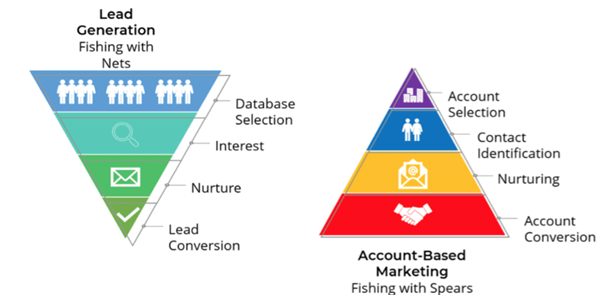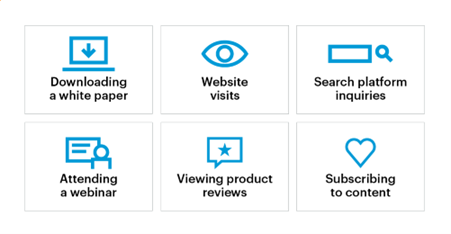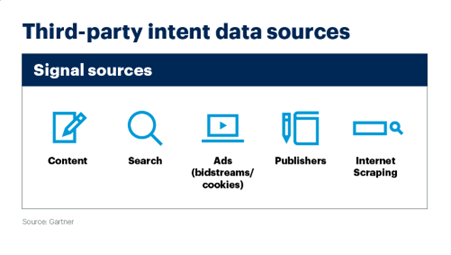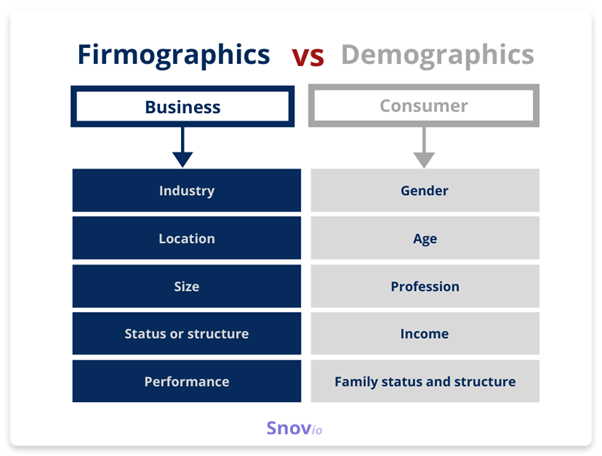In the fast-paced and ever-evolving world of B2B marketing, companies are constantly looking for ways to stay ahead of the competition. One such tool that has gained popularity in recent years is B2B intent data.
According to Professional Insights, almost 40% of businesses spend more than half of their marketing budget on intent data, and 70% plan to spend more on it next year.B2B Intent Data is information gleaned from a company's digital activity in order to forecast buyer intent.
Intent data can be generated by tracking searches, website visits, and downloads, allowing your sales and marketing teams to generate targeted leads. In the case of account-based marketing, intent data incorporating context, relevance, and timing helps your business increase revenue, reduce sales cycles, and reduce client acquisition costs.

By identifying and prioritizing leads based on the signals they express across the web, intent data assists B2B professionals in optimizing the B2B lead generation process. Intent data is made up of billions of signals generated by users across the Internet. These signals reveal which products, features, and content your target audience is looking for.
In this article, we will explore what B2B intent data is, how it is collected, its importance, and the role it plays in driving sales and marketing. We will also provide strategies on how to use B2B intent data to drive ROI and sales.
What is B2B Intent Data?
B2B intent data is a type of data that indicates the likelihood of a company or individual making a deal. It is based on the digital footprints left behind by a user’s online behavior, such as website visits, content downloads, searches, and social media engagement. By analyzing this data, businesses can gain insights into the interests and buying intentions of their target audience.
B2B intent data can be collected either through a company's website or marketing automation platform or from external sources such as data providers or publishers. The use of B2B intent data can help businesses to personalize their outreach efforts and increase the chances of conversion.
Consider this classic intent data example where if you sell marketing software, you may notice that your target audience is looking for "how to improve the SEO of my website." You can use this information to create content that meets the needs of your target audience.
Types of B2B Intent Data and How it is Collected?
There are two types of B2B intent data: first-party and third-party intent data. First-party intent data is collected directly from a company's website or marketing automation platform, while third-party intent data is obtained from external sources, such as data providers or publishers.
Tracking pixels, cookies, and scripts that capture the user's digital activity are used to collect B2B intent data. This information is then analyzed with machine learning algorithms to identify patterns and predict purchasing intent. Such integrations lead to the building of better ROI and a strong sales pipeline.
First-party intent data: This type of data is gathered by tracking pixels, scripts, and cookies placed on the website or marketing channels. First-party intent data is the information collected from website visits, content downloads, email engagement, and social media interactions, among others.

Third-party intent data, on the other hand, is obtained from external sources, such as data providers, publishers, and content syndicators. This type of data provides insights into the interests and behavior of target prospects who are not yet engaging with a particular company. Third-party intent data may include data such as B2B purchase intent data, firmographics, and technographic.

The collection of B2B intent data is done using intent data software having machine learning and artificial intelligence-powered algorithms that analyze the user's digital activity and search behavior. These algorithms help in identifying patterns and predict buying intent based on the user's behavior. B2B intent data is collected by tracking the user's digital activity through cookies, web beacons, and tracking pixels on the user's browser or mobile device. This data is then analyzed by algorithms that use natural language processing and other machine learning techniques to provide insights into the user's interests and behaviors.
In addition to these, B2B intent data can also be collected through social listening, which involves monitoring social media for signals related to specific topics, keywords, or hashtags. B2B intent data can be collected in real-time, providing businesses with a wealth of information about their target audience's interests and behavior, which can help to drive more effective marketing and sales campaigns.
Importance of Intent Data versus Other Data
Intent data is valuable because it provides real-time information on the buying intentions of prospects, making it easier to target them with relevant and personalized content. Other types of data, such as demographics or firmographics, can provide insights into a prospect's background, but they do not necessarily indicate a buying intent.

The importance of intent data lies in its ability to provide businesses with a more accurate and detailed picture of their target audience's buying intent and behavior. Compared to other types of data, such as demographics and firmographics, intent data provides insights into a user's interests and behavior, enabling salespeople to target prospects who are more likely to make a purchase.
Here are some of the key advantages of using intent data compared to other types of data:
Increased Accuracy
Intent data is based on a user's actual behavior and engagement with a brand, making it more accurate than other types of data, such as demographic or firmographic data, which may not reflect a user's current interests or buying intent.
Personalized Messaging
Intent data enables businesses to personalize their outreach efforts to target prospects who are most likely to engage with their brand. By tailoring their messaging to the user's interests and behavior, businesses can increase the chances of conversion.
Improved Lead Scoring
Intent data enables businesses to capture lead scores based on their likelihood of conversion. Intent data helps in identifying prospects who are actively researching a particular product or service, businesses can prioritize these leads and focus their outreach efforts on those who are more likely to make a purchase.
Better ROI
Intent data can help businesses to drive better ROI from their marketing and sales efforts by enabling them to target prospects who are more likely to convert. This can help to reduce wastage and improve the efficiency of their campaigns. The intent data marketing campaigns also keep you ahead of competitors.
Intent data provides a more detailed and accurate picture of a user's interests and behavior, enabling businesses to target their outreach efforts more effectively and increase the chances of conversion. By using intent data, messages can be personalized, lead scores can be improved, and businesses can build stronger relationships with their clients.
Role of Intent Data in B2B Sales and Marketing
With intent data, you can gain insight into your market and gain an advantage over the competition. Even cold calls become more effective when they include intent data from recent activities by understanding what prospects are likely to do next.
Marketers or salespeople can use intent data to prioritize activities and explore new markets more effectively than ever before. Businesses with intent data have the opportunity to gain tremendous insights into customer needs and preferences, transforming the approach to marketing endeavors. Intent data also enables businesses to personalize their messaging and target prospects who are most likely to make a purchase.
Here are some of the ways in which intent data can be used in B2B sales and marketing:
Identify Prospects
Intent data can help businesses to identify potential customers who are actively researching products or services. By analyzing a user's online behavior, businesses can identify the specific topics or keywords that a user is searching for, which can help to identify their needs and interests.
Personalize Messaging
Intent data enables businesses to personalize their messaging to target prospects who are most likely to engage with their brand. By tailoring their messaging to the user's interests and behavior, businesses can increase the chances of conversion.
Prioritize Leads
Intent data can help businesses to prioritize leads based on their likelihood of conversion. By using intent data to identify prospects who are actively researching a particular product or service, businesses can focus their outreach efforts on those who are more likely to make a purchase.
Improve Sales Efficiency
Intent data can help businesses to improve the efficiency of their sales efforts by providing sales teams with more detailed and accurate information about their prospects. By providing sales teams with insights into a prospect's interests and behavior, businesses can improve the quality of their outreach efforts and reduce the time spent on unqualified leads.
Better ROI
Intent data can help businesses to drive better ROI from their marketing and sales efforts by enabling them to target prospects who are more likely to convert. This can help to reduce wastage and improve the efficiency of their campaigns.
Intent data plays a crucial role in B2B sales and marketing by helping businesses to identify potential customers who are actively looking to buy a product or service. By using intent data, businesses can personalize their messaging, prioritize leads, improve sales efficiency, and drive better ROI from their marketing and sales efforts.
Strategies to use B2B Intent Data for Different Signal Types
There are several signal types that intent data can provide, including company-level intent, topic-level intent, and account-level intent. Here are some strategies on how to use B2B intent data for each signal type:
Company-level intent: Use company-level intent data to identify companies that are showing interest in your industry or solution. This data can be used to prioritize your outreach efforts and tailor your messaging to the company's specific needs.
Topic-level intent: Use topic-level intent data to identify the particular topic or keywords that your prospects are searching for. This data can be used to create targeted content and ads that address the prospect's interests and pain points. When someone enters a keyword or phrase into a search engine, search intent data is collected (e.g., Google, Bing). You can use this data to identify the types of queries your target audience is looking for and provide the most relevant answers
Account-level intent: Use account-level intent data to identify the specific individuals within a company who are showing interest in your solution. This data can be used to personalize your outreach efforts and engage with the right decision-makers.
B2B intent data provides insights into a user's interests and behavior, enabling businesses to personalize their outreach efforts and target prospects who are most likely to make a purchase.
Strategies to use B2B intent data for different signal types:
Keyword-Based Signals
Keyword-based signals are based on the specific keywords that a user has searched for. To use keyword-based signals, businesses can analyze search queries to identify the specific keywords that a user is searching for. This can help businesses to identify potential customers who are actively researching a particular product or service.
Content Consumption Signals
Content consumption signals are based on the content that a user has consumed. To use content consumption signals, businesses can track a user's activity on their website, such as the pages they have visited or the content they have downloaded. This can help businesses to identify potential customers who are interested in their products or services.
Firmographic Signals
Firmographic signals are based on a user's company or industry. To use firmographic signals, businesses can analyze a user's company size, industry, location, and other relevant data points. This can help businesses to identify potential customers who fit their ideal customer profile.
Technographic Signals
Technographic signals are based on the technology that a user is using. To use technographic signals, businesses can analyze a user's technology stack, such as the software they are using or the devices they are using to access the internet. This can help businesses to identify potential customers who may be a good fit for their products or services.
Engagement Signals
Engagement signals are based on a user's engagement with a brand. To use engagement signals, businesses can track a user's activity on their website, such as the pages they have visited or the content they have interacted with. This can help businesses to identify potential customers who are actively engaging with their brand and are more likely to make a purchase.
B2B intent data can be used for different signal types, including keyword-based signals, content consumption signals, firmographic signals, technographic signals, and engagement signals. By analyzing these different signal types, businesses can identify potential customers who are actively researching products or services, are interested in their products or services, fit their ideal customer profile, or engaging with their brand. This can help businesses to personalize their outreach efforts and target prospects who are more likely to make a purchase.
How to Use B2B Intent Data for Your Business?
In this competitive market using B2B intent data can be a powerful way for businesses to identify potential clients who are actively researching products or services and are more likely to make a purchase. Here are some strategies on how to use B2B intent data for your business:
Identify Target Accounts: B2B intent data can help businesses to identify prospective accounts based on their online behavior. By analyzing a user's online behavior, businesses can identify the specific topics or keywords that a user is searching for and target accounts that match their ideal client profile.
Personalized Outreach Efforts: B2B intent data enables businesses in personalizing their messages and outreach efforts based on a user's interests and behavior. By tailoring their messaging and advertising campaigns to the user's needs and interests, businesses can increase the chances of conversion and build a stronger relationship with their prospects.
Prioritize Leads: B2B intent data can help businesses to prioritize leads based on their likelihood of conversion. By using intent data to identify prospects who are actively researching a particular product or service, businesses can focus their outreach efforts on those who are more likely to make a purchase.
Align Sales and Marketing Efforts: B2B intent data can help businesses to align their sales and marketing efforts. By sharing intent data between sales and marketing teams, businesses can improve the quality of their outreach efforts and reduce the time spent on unqualified leads.
Measure Campaign Effectiveness: B2B intent data can help businesses to measure the effectiveness of their marketing and sales campaigns. By tracking a user's online behavior, businesses can identify which campaigns are driving the most engagement and adjust their strategies accordingly.
Continuously Refine Your Strategy: B2B intent data provides businesses with valuable insights into their prospects' interests and behavior. By continuously analyzing this data, businesses can refine their strategies and messaging to better target their ideal customers.
Conclusion
In summary, B2B intent data can be a powerful tool for businesses to identify potential clients who are actively researching products or services and are more likely to make a purchase. The team of experts at S2W Media can help you develop a powerful marketing strategy using intent data to identify your target accounts, personalize outreach efforts, prioritize leads, and align sales and marketing efforts.

_MI-Jul-21-2025-12-05-24-8609-PM.png?width=390&height=195&name=63dbb9e116846d3e66f58437_MicrosoftTeams-image%20(119)_MI-Jul-21-2025-12-05-24-8609-PM.png)

